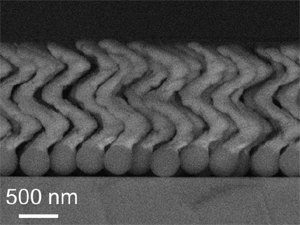



Date:07/11/18
 An international team of scientists has developed a nano-scale robot that can 'drill' into the tissue of an eye without damaging it.
An international team of scientists has developed a nano-scale robot that can 'drill' into the tissue of an eye without damaging it.
The robot, which is shaped like a propeller, is just 500nm wide and covered with a non-stick coating, enabling it to slip through the dense tissue of the eye and move around freely. A tiny amount of magnetic material means it can be steered from outside the body using magnetic fields.
The researchers compared the tissue matrix inside the eye to a web of double-sided sticky tape. To avoid the nanopropeller getting stuck, they developed a special two-part coating: a layer of molecules bound to the propeller's surface, and a slippery non-stick finish.
“For the coating we look to nature for inspiration,” said Dr Zhiguang Wu, a postdoctoral researcher at the Max Planck Institute for Intelligent Systems. “In the second step, we applied a liquid layer found on the carnivorous pitcher plant, which has a slippery surface on the peristome to catch insects. It is like the Teflon coating of a frying pan.
"This slippery coating is crucial for the efficient propulsion of our robots inside the eye, as it minimizes the adhesion between the biological protein network in the vitreous and the surface of our nanorobots."
Ultimately, the researchers hope that a swarm of the nanobots could be loaded with medication, and used to deliver it precisely where it's needed.
Scientists develop nano-scale robot that ‘drills’ into eyes without damaging them
 An international team of scientists has developed a nano-scale robot that can 'drill' into the tissue of an eye without damaging it.
An international team of scientists has developed a nano-scale robot that can 'drill' into the tissue of an eye without damaging it.The robot, which is shaped like a propeller, is just 500nm wide and covered with a non-stick coating, enabling it to slip through the dense tissue of the eye and move around freely. A tiny amount of magnetic material means it can be steered from outside the body using magnetic fields.
The researchers compared the tissue matrix inside the eye to a web of double-sided sticky tape. To avoid the nanopropeller getting stuck, they developed a special two-part coating: a layer of molecules bound to the propeller's surface, and a slippery non-stick finish.
“For the coating we look to nature for inspiration,” said Dr Zhiguang Wu, a postdoctoral researcher at the Max Planck Institute for Intelligent Systems. “In the second step, we applied a liquid layer found on the carnivorous pitcher plant, which has a slippery surface on the peristome to catch insects. It is like the Teflon coating of a frying pan.
"This slippery coating is crucial for the efficient propulsion of our robots inside the eye, as it minimizes the adhesion between the biological protein network in the vitreous and the surface of our nanorobots."
Ultimately, the researchers hope that a swarm of the nanobots could be loaded with medication, and used to deliver it precisely where it's needed.
Views: 466
©ictnews.az. All rights reserved.Similar news
- The mobile sector continues its lead
- Facebook counted 600 million active users
- Cell phone testing laboratory is planned to be built in Azerbaijan
- Tablets and riders outfitted quickly with 3G/4G modems
- The number of digital TV channels will double to 24 units
- Tax proposal in China gets massive online feedback
- Malaysia to implement biometric system at all entry points
- Korea to build Green Technology Centre
- Cisco Poised to Help China Keep an Eye on Its Citizens
- 3G speed in Azerbaijan is higher than in UK
- Government of Canada Announces Investment in Green Innovation for Canada
- Electric cars in Azerbaijan
- Dominican Republic Govt Issues Cashless Benefits
- Spain raises €1.65bn from spectrum auction
- Camden Council boosts mobile security





















